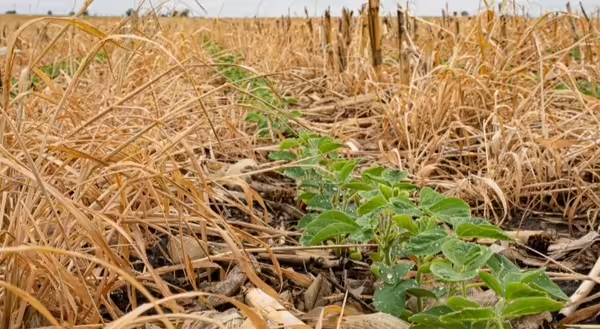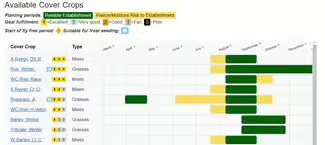
Choosing the right cover crop can be a daunting task, whether it is the first time you’re planting a cover crop or you're deciding to switch to something new. With countless options and complex factors to consider, it can be difficult to determine which is the best cover crop for your operation. In this post I’ll discuss what is the most important information to know and explore a tool that can make this process a lot easier.
To decide which cover crop is best for your operation, we first need to understand a little bit about the biology and ecology of these different plants. Cover crops can be categorized based on their functional group, growth cycle, and seasonality. A functional group is a group of plant species that shares similar traits, like how they grow and interact with their environment.
Most cover crops fit into four functional groups: grasses, legumes, broadleaves, and brassicas.
Grasses
Benefits: prevent erosion, scavenge nutrients, suppress nematodes, facilitate cash crop establishment, build soil organic matter
Examples: cereal rye, oats, annual ryegrass, sorghum sudangrass
Legumes
Benefits: nitrogen source, green manure
Examples: crimson clover, cowpea, hairy vetch, red clover, sunn hemp
Broadleaves
Benefits: weed suppression, support beneficial insects
Examples: buckwheat
Brassicas
Benefits: reduce soil compaction, weed suppression
Examples: mustard, radish
Cover crops can also be grouped into cool season and warm season varieties based on what conditions the plant grows best in.
Cool season cover crops are planted in the fall and either overwinter and resume growth in the spring or are winter-killed and will self-terminate after multiple frosts. Winter-killed cover crops need to be planted earlier than those that overwinter. Overwintering cover crops will need to be terminated in the spring, which often means applying a herbicide weeks prior to planting the cash crop. Whether a cover crop is winter-killed or can overwinter is also dependent on weather conditions. In a year with a mild winter, some crops will overwinter that would typically be winter-killed. Some examples of cool season cover crops that overwinter are crimson clover and winter rye. Some examples of cool season cover crops that winter-kill are tillage radish and oats.
Warm season cover crops are planted in the spring or early summer to help prepare a field for the cash crop. Some examples of warm season cover crops are buckwheat, cowpeas, and sorghum sudangrass. In Illinois, most cover crops used in commercial corn/soy rotations are cool season varieties that have some ability to overwinter. Because of the timing of harvest of corn and soy, it can be difficult to get a cover crop established before it becomes too cold. For many cover crops, their ability to overwinter is dependent on how much growth happens before frost.
The last way cover crops can be classified is by their growth cycle.
Cover crops can be annual, biennial, or perennial. Annuals complete their life cycle in one growing season. Biennials complete their life cycle in two growing seasons—in the first year they grow and overwinter and in the next they flower and reproduce. Perennials can live for multiple years and will often reproduce yearly. The below chart from the USDA Agricultural Research Service summarizes these different groups.
With all of these factors to consider, it can be difficult for growers to choose the right cover crop for them. One tool that makes this process easier is the Midwest Cover Crops Council’s Cover Crop Decision Tool. This tool helps growers select a cover crop based on their location and goals. Some of the goals included are erosion fighter, nitrogen source, soil builder, and weed fighter. The tool then lists and ranks the cover crops that will best meet the selected goals. It also lists the best time to plant each crop to get reliable establishment. Below is an example of what that output looks like. The Midwest Cover Crop Council also offers many resources on their website, including termination, planting, and management guides.
Want to learn more about cover crops or trouble shoot issues with fellow growers? Join us for an informal Cover Crop Roundtable Discussion on August 28, 2024 at the Marshall-Putnam Extension Office.
Emily Hansen is a Commercial Agriculture Educator with University of Illinois Extension, serving Bureau, LaSalle, Marshall, and Putnam counties. Emily provides research-based educational programs that empower growers to make sustainable choices on their farms.
Getting Started – Midwest Cover Crops Council. (n.d.). Retrieved August 5, 2024, from https://www.midwestcovercrops.org/getting-started-correct/
SARE Outreach. (2008). Managing Cover Crops Profitably (3rd Ed. ). DIANE Publishing.

